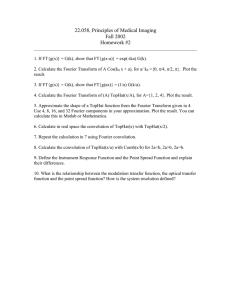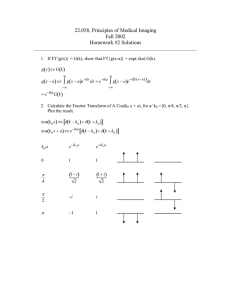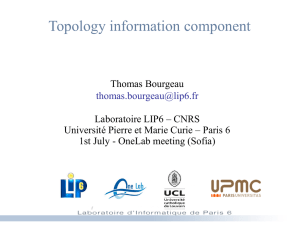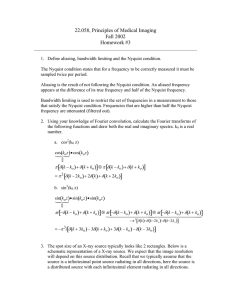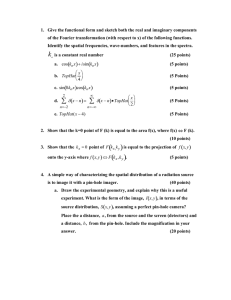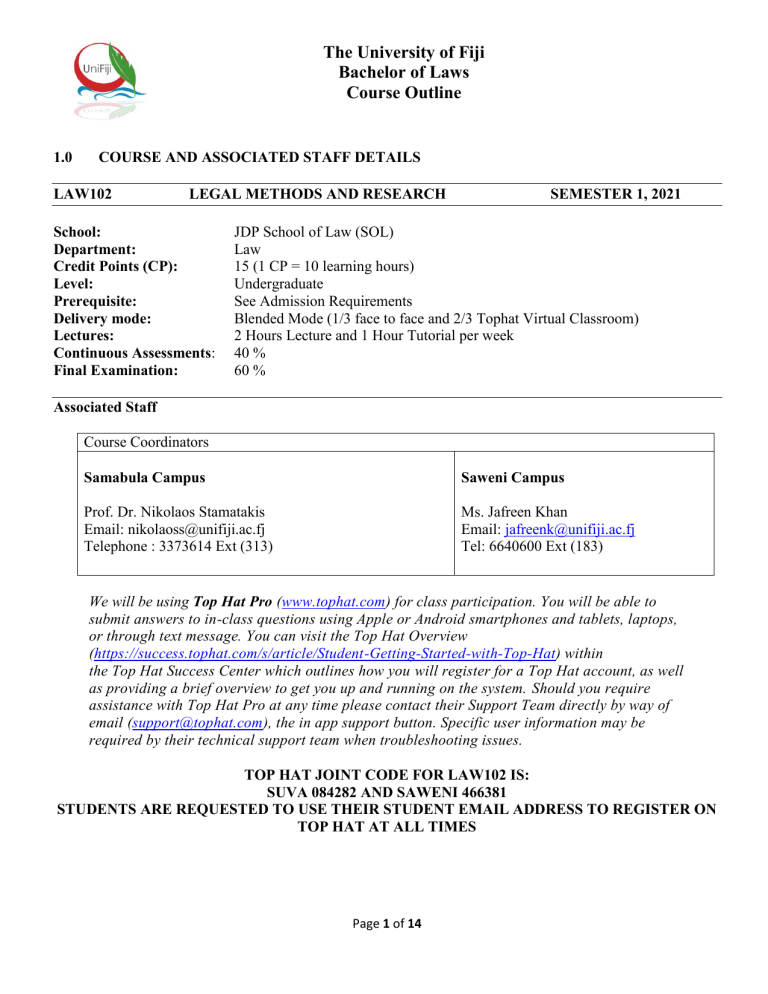
The University of Fiji Bachelor of Laws Course Outline 1.0 COURSE AND ASSOCIATED STAFF DETAILS LAW102 LEGAL METHODS AND RESEARCH School: Department: Credit Points (CP): Level: Prerequisite: Delivery mode: Lectures: Continuous Assessments: Final Examination: SEMESTER 1, 2021 JDP School of Law (SOL) Law 15 (1 CP = 10 learning hours) Undergraduate See Admission Requirements Blended Mode (1/3 face to face and 2/3 Tophat Virtual Classroom) 2 Hours Lecture and 1 Hour Tutorial per week 40 % 60 % Associated Staff Course Coordinators Samabula Campus Saweni Campus Prof. Dr. Nikolaos Stamatakis Email: nikolaoss@unifiji.ac.fj Telephone : 3373614 Ext (313) Ms. Jafreen Khan Email: jafreenk@unifiji.ac.fj Tel: 6640600 Ext (183) We will be using Top Hat Pro (www.tophat.com) for class participation. You will be able to submit answers to in-class questions using Apple or Android smartphones and tablets, laptops, or through text message. You can visit the Top Hat Overview (https://success.tophat.com/s/article/Student-Getting-Started-with-Top-Hat) within the Top Hat Success Center which outlines how you will register for a Top Hat account, as well as providing a brief overview to get you up and running on the system. Should you require assistance with Top Hat Pro at any time please contact their Support Team directly by way of email (support@tophat.com), the in app support button. Specific user information may be required by their technical support team when troubleshooting issues. TOP HAT JOINT CODE FOR LAW102 IS: SUVA 084282 AND SAWENI 466381 STUDENTS ARE REQUESTED TO USE THEIR STUDENT EMAIL ADDRESS TO REGISTER ON TOP HAT AT ALL TIMES Page 1 of 14 2.0 DESCRIPTION AND STRUCTURE OF THE COURSE This methodology course provides students with knowledge and analytical skills, including practical/hands-on writing skills, to conduct legal research. Students are expected to become highly competent in legal writing, speaking, and debating ideas and concepts. They will develop legal study skills, for example mind-mapping and conceptualising legal ideas. Students must analyse judicial decisions, understand legal arguments and reasoning, undertake a wide variety of research tasks, and learn how to use the School of Law Referencing Guide. The 'Bema' (oratory platform) methodology helps students with public speaking, and mooting and debates allow them to develop advocacy skills. This course must be understood in relation to LAW100 and LAW101. 3.0 LLB PROGRAMME: PURPOSE AND GRADUATE PROFILE Purpose: The purpose of the LLB programme is to provide law-related professions with lawyers and advocates who have a solid foundation in substantive and procedural aspects of the law. Graduate Profile: The LLB programme strives to produce graduates who are – Effective Advocates Demonstrate confidence and develop appropriate courtroom etiquette Argue legal positions persuasively to a range of audiences Develop improvisational skills and successfully adjust to unpredictable situations Legal Researchers and Writers Conduct legal research using multiple sources such as legislation, case law, and policy documents Apply the law to factual scenarios using persuasive and analytical writing skills Exercise autonomy when examining novel or complex legal issues Understand how to draft and implement legal policy Ethical Identify and critically evaluate ethical dilemmas according to professional standards Practice with integrity, compassion, and professionalism in various contexts 4. 0 COURSE LEARNING OUTCOMES (CLOs) Students will learn the major concepts, case law, theoretical perspectives, empirical findings and basic structures involved in the process of law-making and law enforcement. On successful completion of this unit students will be able to: CLO #1 CLO #2 CLO #3 CLO #4 CLO #5 Demonstrate proficiency in verbal and written legal English, and develop flair for litigation purposes Formulate legal issues, legal arguments and reasoning for a range of factual scenarios Draft a water-tight legal opinion based on given facts in combination with the law Evaluate the distinction between precedent and persuasive value in a legal judgment (Ratio/obiter) Research and critically assess sources of law including journal articles and their reviews; Page 2 of 14 CLO #6 CLO #7 CLO #8 CLO #9 Analyse case law and statutes efficiently to understand the rules Apply statutory rules and case precedents to the facts in a case Engage confidently in oral legal arguments and debates from the Bema Understand broad principles of law and its application in a wide range of issues Page 3 of 14 5.0 COURSE CONTENT: SCHEDULE FOR SEMESTER WEEK (date TBD) LEARNING OUTCOMES TOPIC/SUB TOPICS 1 Rating student capacity and other attributes CLO 1 Course outline overview (i) About the course and how it will be taught (ii) Lecture on Research and Importance of it (iii) Reading and research ASSESSMENT READINGS/ RESOURCES Course Outline TEACHING / LEARNING STRATEGIES Reading: To be provided 2 CLO 1 Citation and Referencing Reading: The Style Guide; Chapter 15 of Laying Down the Law School of Law Referencing Guide (2nd Edition) CLO 1, 2 3 Reading: To be provided Reading and Writing Like a Lawyer: English for Legal Purposes Page 4 of 14 Face to face class Course materials and Readings on TopHat Virtual Classroom. Students engage in private study Consultation via TopHat Communication and information through email (or phone calls if urgent) Preparation for Tutorial Live ONLINE Lecture via TopHat Virtual Classroom Course materials and Readings on TopHat Virtual Classroom. Students engage in private study Consultation via TopHat Communication and information through email (or phone calls if urgent) Preparation for Tutorial Live ONLINE Lecture via TopHat Virtual Classroom Course materials and 4 CLO 2, 5, 9 The Law: Source; and Types (i) Statute (ii) Cases (iii) Regulations (iv) Policy Research Presentation (5%) Face-to-face Assessment Reading: To be provided, and Chapters 2, 7, 9 and of Introduction to Legal Method; Chapters 4 and 7 of Laying Down the Law 5 CLO 2, 6, 7 Reading: Chapter 10 of Introduction to Legal Method; Chapter 8 of Laying Down the Law; and to be provided. Interpretation of Legislation Learning to read and analyse legislation Page 5 of 14 Readings on TopHat Virtual Classroom. Students engage in private study Consultation via TopHat Communication and information through email (or phone calls if urgent) Preparation for Tutorial Face- to-face Lecture/Tutorial Course materials and Readings on TopHat Virtual Classroom. Students engage in private study Consultation via TopHat Communication and information through email (or phone calls if urgent) Preparation for Tutorial Live ONLINE Lecture via TopHat Virtual Classroom Course materials and Readings on TopHat Virtual Classroom. Students engage in private study Consultation via TopHat Communication and information through email (or phone calls if urgent) Preparation for Tutorial 6 CLO 2, 6, 7 Reading: Chapter 4 of Laying Down the Law Legal Cases: what are they? 7 CLO 2-7 Reading: Chapter 11 Laying Down the Law; Chapters 7 & 8 Introduction to Legal Method Understanding case law: Doctrine, precedents, ratio, obiter, decision-making values. Justice v Law 8 9 Live ONLINE Lecture via TopHat Virtual Classroom Course materials and Readings on TopHat Virtual Classroom. Students engage in private study Consultation via TopHat Communication and information through email (or phone calls if urgent) Preparation for Tutorial Live ONLINE Lecture via TopHat Virtual Classroom Course materials and Readings on TopHat Virtual Classroom. Students engage in private study Consultation via TopHat Communication and information through email (or phone calls if urgent) Preparation for Tutorial MID SEMESTER BREAK CLO 1-9 English for Legal Purposes (i) Communication Research Paper 5% To be submitted online via Moodle Reading: to be provided, and Chapter 14 Laying down the Law Page 6 of 14 Live ONLINE Lecture via TopHat Virtual Classroom Course materials and Readings on TopHat Virtual Classroom. Students engage in private 10 CLO 1, 2, 7, 8 Reading: to be provided, and Chapter 14 Laying down the Law English for Legal Purposes (ii) Communication 11 CLO 2, 6, 7 Reading: Chapters 9, 10 and 11 of Laying Down the Law Primary and Secondary Sources in Legal Research (i) Case law (ii) Statute law (iii) Delegated legislation Page 7 of 14 study Consultation via TopHat Communication and information through email (or phone calls if urgent) Preparation for Tutorial Live ONLINE Lecture via TopHat Virtual Classroom Course materials and Readings on TopHat Virtual Classroom. Students engage in private study Consultation via TopHat Communication and information through email (or phone calls if urgent) Preparation for Tutorial Mooting Exercise to be handed out Face- to-face Lecture/Tutorial Course materials and Readings on TopHat Virtual Classroom. Students engage in private study Consultation via TopHat Communication and information through email (or phone calls if urgent) Preparation for Tutorial 12 CLO 1-9 Visit to Court or Parliament Parliament or Court Visit Report 5% To be submitted online via Moodle Reading: to be provided 13 CLO 1, 2, 7, 8, 9 Mooting Mooting 10% Face-to-face Assessment Reading: A Guide to Moot Competition: Preparation and Presentation By Ronald Singh 14 Revision Class: Exam skills Page 8 of 14 Live ONLINE Lecture via TopHat Virtual Classroom Course materials and Readings on TopHat Virtual Classroom. Students engage in private study Consultation via TopHat Communication and information through email (or phone calls if urgent) Preparation for Tutorial Face- to-face Lecture/Tutorial Course materials and Readings on TopHat Virtual Classroom. Students engage in private study Consultation via TopHat Communication and information through email (or phone calls if urgent) Preparation for Tutorial Live 2-hour discussion/ revision and recapping of Course via Top Hat Virtual Classroom Consultation via Meet/Zoom Students engage in private study. Students prepare for final 15 16/17 Study Break Final Examination – date TBA Final Exam 60% Page 9 of 14 exams. Private study Private study 6.0 LEARNING STRATEGIES A combination of teaching/learning techniques will be utilised including lecture, discussion, practical application of acquired skills (e.g., speaking exercises), and private study. Students will learn through weekly Online lectures, Face-to-face lectures and tutorials (scheduled in Week 1, 4, 11 and 13) and Online discussions and individual student participation through preparing discussion/debate during tutorials, Test, Written Assignments, Moot and Final Examination. Generally, all the lectures will be 2 hours long and online tutorials will be 1 hour. However, during face-toface tutorials the lecturer may take 2 hours to engage in discussions and to provide feedback for discussions and debate. 7.0 WORKLOAD (1 credit point = 10 learning hours) Learning Activity Weeks Hours per Week Lecture 14 2 Tutorials 14 1 Research 4 4 Presentation Research paper 4 4 Parliament/Court 1 6 Visit Moot 4 6 Private Study (Includes time spent for assessments such as revisions for exams, research, etc.) Total 8.0 Total Hours Per Semester 28 14 16 Credit Points 16 6 1.6 0.6 24 46 2.4 4.6 150 15 2.8 1.4 1.6 ONLINE SUPPORT Resources in the form of lecture notes, tutorials, course outline, background material, various user guides, practice tests, sample code, data files and weekly quizzes (if applicable) will be made available through TopHat Pro www.tophat.com Paclii is a database of cases, statues and other legal material from the Pacific Islands. The URL or internet address for Paclii is http: www.paclii.org. You will need to use Paclii throughout this course in order to find laws and cases. 9.0 ASSESSMENT This course is assessed by internal assessment, worth 40 marks and final examination worth 60 marks. In order to PASS the course, students MUST obtain 50% of the total mark in the internal assessment and also MUST obtain 50% of the total mark in the Final Exam. In other words - you MUST pass both components in order to pass the course. Students will be assessed as follows: Page 10 of 14 Assessment task Due date Weight % Research Presentation Week 4 5 Research Paper/Write-up Week 9 5 Parliament/ Court Visit Report Week 12 5 Mooting Week 13 10 Attendance On-going 7 Participation 8 Final Examination 60 100% Total The course and assessments must be completed to the satisfaction of the coordinator for the course. 10.0 DETAILED ASSESSMENT FOR THE SEMESTER Specific due dates will be released in due course by the respective lecturers for the Internal Assessments. There will be a total of 5 continuous assessments (including Attendance and Participation component) and a final exam. Specific due dates will be released in due course by the respective lecturers. Research Presentation 5% Based on a topic of students choice (in consultation with their lecturer) where students prepare a presentation up to 15 minutes. This assessment will be marked according to a marking rubric that will be provided by the lecturer. Research Paper 5% Written assignment would be between 1,500 to 2,000 words which is based on the Research Presentation. Students will have to show their research, referencing and citation skills by producing a well written paper. This assessment will be marked according to a marking rubric that will be provided by the lecturer. NO ASSIGNMENT will be accepted after 7 days of the due date and penalties would apply. Parliament/Court Visit Report 5% Students will have to prepare a Report based on their visit and experience to the Parliament/Court. Moot 10% For Moot students will be expected to work in pairs. This is a face-to-face assessment. Page 11 of 14 Moot scenario will be based on a problem situation which will require preparation and discussion fit for an Appeal Court. There will be a detailed marking rubric attached with the Moot question and each student has to fulfil the requirements for both oral and written submissions. Since moot will take place face-to-face students are urged to adhere to the time and duration of presentation. Attendance and Participation [15%] Every lecture and tutorial is compulsory in this course. Attendance will be taken every lecture and tutorial on TopHat. Students will be expected to enter the TopHat attendance code when it will be generated during class. Be warned that this code is not to be shared with people who are not present during classes or actively participating. Participation percentage will be based on attendance to the session and also requires meaningful participationdiscussion, debate, questions, typing, chatting, and submission of tutorial answers. 11.0 LATE ASSIGNMENTS Late submission of assignment will incur a penalty of 5% of the marked assignment. No assignment will be accepted after the 7th day of the respective assessment’s due-date.' 12.0 GRADING SYSTEM The use of alphabets as means of a grading system has been in existence over many decades. In order to make the grading system consistent at the University of Fiji the following structure will be implemented from this semester. Grade A+ A B+ B C+ C D E Meaning Superior far exceeds average understanding as evidenced in course work and goes significantly beyond the basics. Excellent, exceeds average understanding as evidenced in course work and goes well beyond the basics. Far above average, meets or exceeds average understanding as evidenced in course work and fully understands the basics and goes somewhat beyond that level. Far above average, fully meets average understanding as evidenced in course work and fully understands the basics and can deal with concepts somewhat beyond that level. Just above average, fully meets expectations for basic understanding as evidenced in coursework and fully understands the basics and can deal with concepts at that level. Average, meets minimum expectations and satisfies course requirements. Fails to meet minimum expectations in understanding and course work as evidenced by performance and submission of graded elements. Well below the minimum standards. This is when one gets a mark of less than 40%. It represents lack of effort/interest. It is a cause for deep concern Page 12 of 14 Marks 85+ 80 - 84 75 - 79 65 - 74 60 - 64 50 - 59 40 - 49 0 - 39 13.0 WITHDRAWAL FROM COURSE Students who wish to withdraw from courses for which they do not wish to be assessed must inform the Registrar on the prescribed from, by the second Friday of the Semester in which case the fees for those courses shall be refunded in full. Each week of delay after this will incur a penalty of 25% of the fee. No fee would be refunded after the fifth Friday of the semester. The final date of withdrawal is the first Friday after the mid-semester break. Students who withdraw after the deadline stated above shall be charged full fees. Students who withdraw from courses during the semester shall be recorded as having withdrawn from that course and their names shall be removed from the course lists. Students who do not formally withdraw from a course but cease attending classes or doing exams shall be recorded as having failed the course. Getting a failed grade will also affect the GPA (refer to University Handbook). 14.0 REFERENCING GUIDELINES The University has its own referencing style contained in The University of Fiji School of Law Referencing Style Guide, 3rd Edition. The referencing style must be used consistently and fully. Please ensure that all assessment items submitted are properly referenced. Failure to provide references would result in disciplinary action under the University’s Plagiarism and Dishonest Practice Regulations. 15.0 PLAGIARISM AND DISHONEST PRACTICE Plagiarism or Collusion a) When a marker finds a student of plagiarism or collusion, the piece of academic work MUST be brought to the attention of the course coordinator concerned. b) The course coordinator will endeavour to locate the sources from which this student has plagiarized. If satisfied that the student has plagiarized, the course coordinator will collate the evidence of the breach for record purposes and submit the evidence at the earliest opportunity to the respective Deans. It will include a copy of the academic work and a list of sources, page numbers and/or copies of the plagiarized sources. c) The student will be notified by the Head of School and issued with an official letter stating the allegations and giving him/her the opportunity to present his/her case. d) If the Dean is satisfied that the student has engaged unknowingly in such behaviours, he/she may implement a penalty according to the provisions of 3.0 below. Mandatory use of Turnitin – plagiarism detection software 1. Students are required to submit all written work through Turnitin via Moodle online to check their work for originality and to ensure that appropriate referencing and citation is used. Turnitin currently accepts the following file types for upload: • Microsoft Word™ (DOC and DOCX) Students are actively encouraged to use Turnitin to check drafts of their written work to improve their writing and guard against unintentional plagiarism. Submitting other students ‘work is strictly not allowed. a. All Turnitin reports will be reviewed. A score of 20% or more on Turnitin will trigger a discussion between the course coordinator and student with consequences if plagiarism is proven. In some cases Page 13 of 14 work with a score of 20% or less can still contain significantly plagiarized content e.g. 10-15% from one source, to which penalties will apply if proven. For more information please visit http://www.UniFiji.ac.fj/index.php?id=2838 Penalties for Academic Misconduct i. Any case of academic misconduct will be reported in writing to the course coordinator, Head of School, and Dean of Faculty. ii. The penalties imposed for proven cases of misconduct vary. Based on the seriousness of the case, the penalties include, but are not limited to: a) A written reprimand of the student from the Head of School; b) The requirement by the Head of School that the student complete further work, or repeat work, for the course. c) Deprivation of credit for a course, or for a component of assessment of the course, to which the academic misconduct relates, by the respective Deans. d) Cancellation of any previously-credited pass in a course associated with the offence, by the respective Deans. iii. Significant and repeat offences will be referred to the University’s Student Discipline Committee, which can: a) Impose a fine not exceeding $500FJD b) Prohibit the student from using any of the University’s library and computing network facilities for a period not exceeding twenty-eight days; c) Recommend to the Vice-Chancellor that a student’s enrolment be suspended for any period and on terms considered necessary by the committee; d) Recommend to the Vice-Chancellor that the student’s enrolment be terminated, i.e. expulsion from the University. 16.0 IMPORTANT POLICIES AND REGULATIONS Your attention is drawn to the following University regulations which are contained in the University Handbook (available online at http://www.unifiji.ac.fj or visit the UniFiji library to view these regulations): Admission, Enrolment, Withdrawal and Auditing Regulations Credit Point System at UniFiji Admission Regulations Programme Regulations Assessment Regulations Cross Credit Regulations Unsatisfactory Progress Regulations Conduct of Examination Regulations Relief of Hardship Regulations Library Information and Regulations Information and Communications Technology (ICT) Policy. Page 14 of 14
